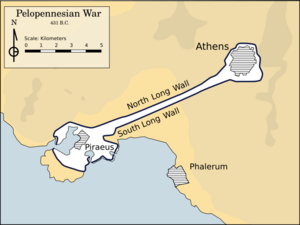Battle of Tanagra (457 BC) facts for kids
Quick facts for kids Battle of Tanagra |
|||||||
|---|---|---|---|---|---|---|---|
| Part of First Peloponnesian War | |||||||
|
|||||||
| Belligerents | |||||||
| Athens | Sparta | ||||||
| Commanders and leaders | |||||||
| Myronides | Nicomedes | ||||||
| Strength | |||||||
| 14,000 | 11,500 | ||||||
| Casualties and losses | |||||||
| Unknown | Unknown | ||||||
The Battle of Tanagra was an important land battle. It happened in Boeotia, a region in ancient Greece, in 457 BC. This battle was fought between two powerful Greek city-states: Athens and Sparta. It was part of a bigger conflict called the First Peloponnesian War.
Tensions between Athens and Sparta had been growing for a while. Athens was rebuilding its city walls, which made Sparta nervous. Also, Sparta had refused help from Athens during a difficult time. In this battle, Athens had about 14,000 soldiers, led by Myronides. Sparta had around 11,500 soldiers, led by Nicomedes. Both sides lost many soldiers. In the end, Sparta won the Battle of Tanagra.
Why the Battle Happened
Before this battle, during the Persian Wars, Sparta led a group of allies called the Peloponnesian League. They became very powerful. Over time, this league, especially Sparta, started to worry about the growing strength of the Athenian Empire. The relationship between them became difficult.
After the Persian Wars, in 478 BC, Sparta told Athens not to rebuild its city walls. Sparta worried that strong walls would make Athens too powerful. But Athens suspected Sparta had other plans. So, Athens secretly started building the walls anyway. They sent their politician Themistocles to Sparta to delay talks. By the time Themistocles told Sparta about the plans, Athens' Long Walls were almost finished.
Later, in 464 BC, Sparta faced a rebellion by their enslaved people, called Helots. Sparta asked its allies, including Athens, for help. Cimon, an Athenian leader, convinced Athens to send a large force. However, Sparta became suspicious. They thought the Athenians might help the Helots instead. So, Sparta sent the Athenian soldiers away. This made Athens feel insulted and angry. Because of this, Athens broke its alliance with Sparta.
In 458 BC, Athens began building the Long Walls. These were long defensive walls that connected Athens to its port, Piraeus. These walls were very important. They allowed Athens to get supplies from the sea, even if enemies surrounded the city. This meant Athens could avoid fighting if they didn't want to.
The Battle Itself
The battle started when people from Phocis attacked cities in Doris. Doris was considered the ancient homeland of the Dorians, a group of Greeks that included the Spartans. Sparta sent an army to help Doris. This army had 1,500 Spartan soldiers and 10,000 soldiers from their allies. They were led by Nicomedes. They marched into Boeotia and made Phocis stop fighting.
Athens was already upset with Sparta. They also suspected Sparta was trying to cause trouble within Athens. They thought Sparta might be trying to stop the building of the Long Walls. So, Athens decided to trap the Spartan army in Boeotia.
Cimon, the Athenian politician who had been exiled, wanted to help Athens. He brought his own soldiers to join the Athenian forces. But the Council of 500, a governing body in Athens, turned him away. They feared his presence would cause problems for the Athenian army.
The Spartan army was now stuck. They could either try to sail home through waters controlled by the Athenian navy. Or, they could march through difficult mountain passes. These passes were held by Athenian soldiers and their allies from Megara. So, the Spartans decided to wait. They hoped for a safe way home or for Athens to attack them directly.
The battle finally took place at Tanagra. The Athenian army had 14,000 soldiers, plus 1,000 allies from Argos. Sparta had 11,500 soldiers, including 1,500 Spartans and 10,000 allied Hoplites (heavily armed foot soldiers). We don't have many details about what happened during the battle itself.
Both Sparta and Athens suffered heavy losses. But Sparta claimed victory. After the battle, the Spartans were able to march home through the mountain passes. On their way, they cut down fruit trees as they passed through the Megarid region.
What Happened Next
Just 62 days after the Battle of Tanagra, the Athenians regrouped. Under the command of Myronides, they defeated Thebes at the Battle of Oenophyta. This victory gave Athens control of Boeotia. They tore down the walls Sparta had built there. Athens also took 100 wealthy men from Opuntian Locris as hostages. With this win, Athens also took control of Phocis and Opuntian Locris.
Years after the Battle of Tanagra, Cimon was allowed to return from exile. He had good connections with both Sparta and Athens. Because of this, Cimon helped create a five-year peace treaty between the two powerful city-states.
Images for kids




